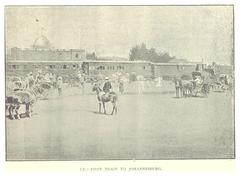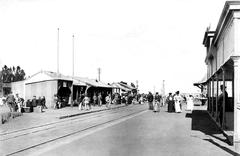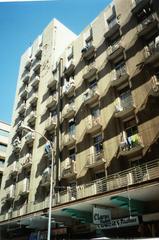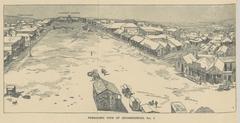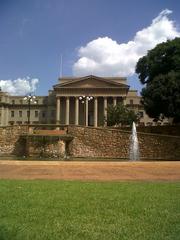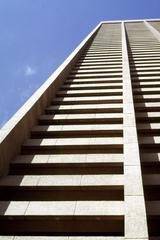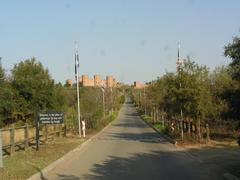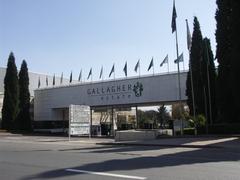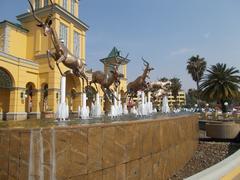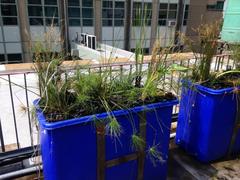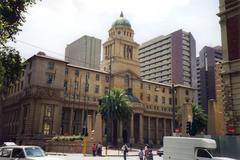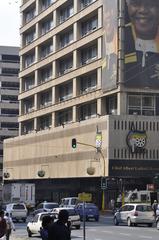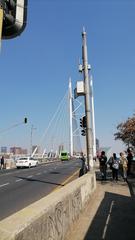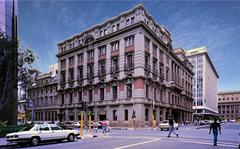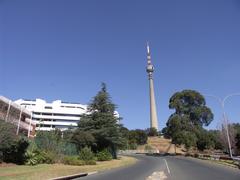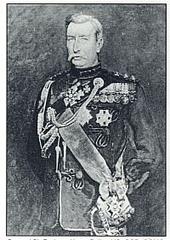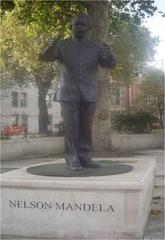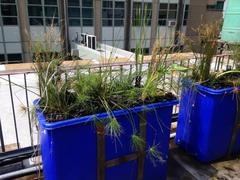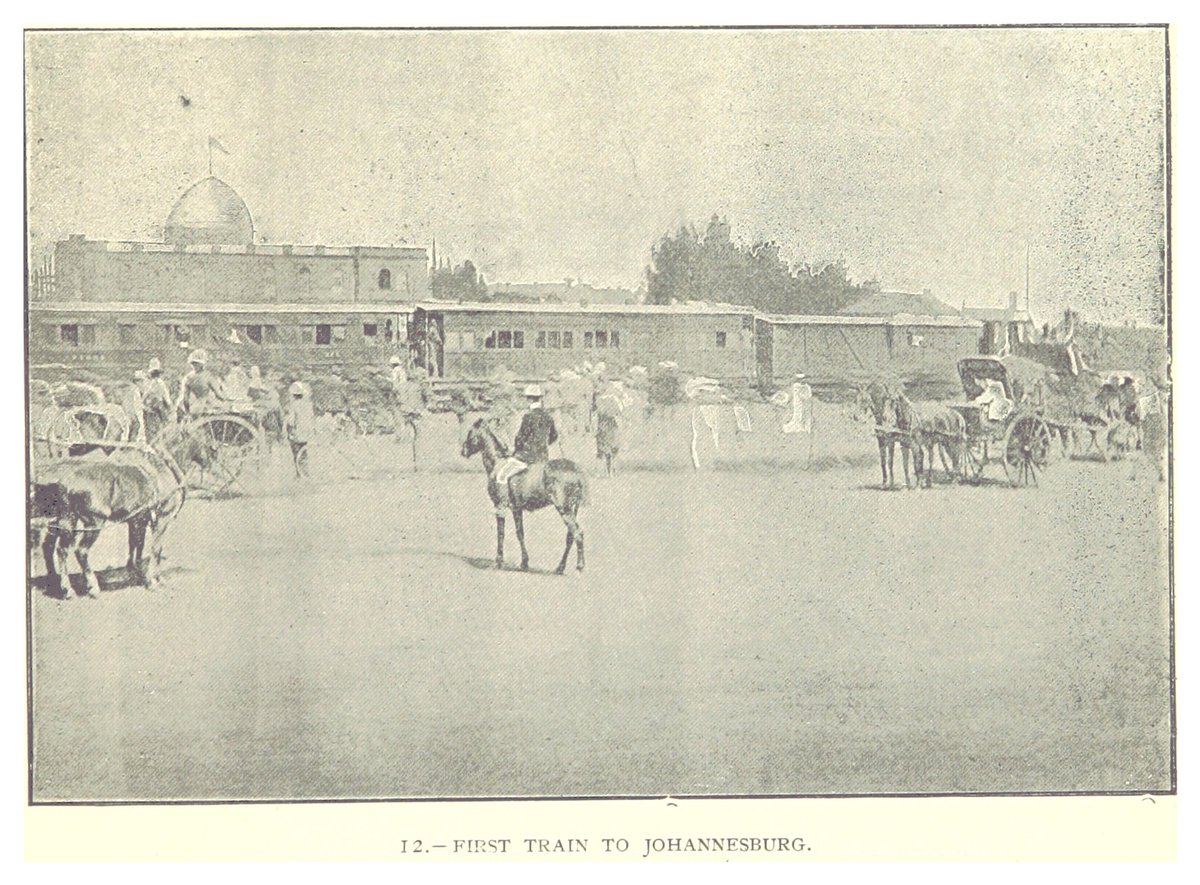
Johannesburg Park Station: Visiting Hours, Tickets, and Complete Travel Guide
Date: 03/07/2025
Introduction
Johannesburg Park Station is not only Africa’s largest railway hub but also a living testament to South Africa’s economic, social, and cultural evolution. As the primary gateway to Johannesburg—South Africa’s most populous city—the station connects millions of travelers each year via trains, buses, and rapid transit systems. Park Station’s unique blend of historic architecture, modern amenities, and central location make it an essential stop for commuters, tourists, and history enthusiasts alike (Heritage Register; wakaabuja.com).
This comprehensive guide covers everything you need to know about Johannesburg Park Station: from its rich history and architectural significance to practical details about visiting hours, ticketing, safety, and nearby attractions. Whether you’re planning a quick transfer or an in-depth exploration, this article will help you make the most of your time at this iconic South African landmark.
Table of Contents
- Origins and Historical Overview
- Architectural Evolution and Heritage Status
- Park Station Today: Facilities and Accessibility
- Transport Connections
- Safety and Security
- Nearby Attractions and Exploring Johannesburg
- Frequently Asked Questions (FAQ)
- Summary and Final Tips
- References
Origins and Historical Overview
Johannesburg Park Station’s origins date back to the gold rush of 1886, when Johannesburg rapidly transformed from a mining camp to a bustling metropolis. The original station, assembled in 1896 from a prefabricated iron structure shipped from the Netherlands, was designed by Dutch architect Jacob Frederik Klinkhamer. Its construction was pivotal in facilitating the city’s explosive growth and the expansion of the Rand Tram suburban rail lines (Heritage Register).
Throughout its history, Park Station played a central role in South Africa’s major historical events, serving as a mobilization hub during the Anglo-Boer Wars and both World Wars. During apartheid, the station became a symbol of both segregation and connection, its facilities reflecting the era’s policies while continuing to serve as a meeting point for people from across the country (Johannesburg1912).
Architectural Evolution and Heritage Status
The original Park Station structure—characterized by its modular ironwork and arched windows—was not only innovative but also designed for relocation. In response to growing passenger numbers, the station underwent significant expansions, culminating in the construction of a modern complex in 1965. The original building was carefully dismantled and preserved, first moved to Esselen Park in 1952 and later relocated to Newtown North in 1993, where it stands as a protected heritage site (Heritage Register).
Today, Old Park Station is one of Johannesburg’s oldest surviving structures and one of only two remaining Rand Tram station buildings, recognized for its rarity and architectural importance (Heritage Register).
Park Station Today: Facilities and Accessibility
Visiting Hours
- Main Station: Open daily from 4:30 AM to 9:00 PM, accommodating the majority of train, bus, and rapid transit services.
- Old Park Station (Heritage Site, Newtown): Accessible during daylight hours. Guided tours are available by appointment through local heritage organizations.
Ticketing: Where and How to Buy
- Gautrain: Tickets can be purchased at automated machines, station kiosks, or online via the official Gautrain website. A Gautrain Gold Card is required for travel.
- Metrorail: Tickets are available at dedicated counters within the station.
- Shosholoza Meyl (Long-Distance): Purchase tickets at the Park Station office or online through official channels.
- Intercity Buses: Companies like Greyhound and Intercape have ticket offices adjacent to the station or offer online booking.
- Discounts: Concessions available for students, seniors, and frequent travelers. Booking in advance is recommended during peak times.
Accessibility Features
Park Station is equipped with:
- Ramps and elevators for wheelchair access
- Tactile indicators for visually impaired travelers
- Designated seating for seniors and those with disabilities
- Staff assistance, available on request
Travelers with specific needs should contact service providers ahead of time to ensure seamless assistance (wakaabuja.com).
Transport Connections
Park Station serves as Johannesburg’s central node for multiple transportation modes:
- Gautrain: Rapid transit to O.R. Tambo International Airport, Sandton, Pretoria, and Rosebank.
- Metrorail: Suburban commuter trains connecting the city to surrounding areas.
- Shosholoza Meyl: Long-distance trains to Cape Town, Durban, and other major cities.
- Rea Vaya BRT: Bus rapid transit routes with stops at and near Park Station.
- Intercity Buses: Including luxury and standard operators for regional and national travel.
- Minibus Taxis: Widely available but best used by seasoned local travelers.
For onward travel, ride-hailing apps like Uber and Bolt are recommended for security and convenience (mykingsgate.co.za).
Safety and Security
As with any major urban transit hub, safety at Park Station requires vigilance:
- Pickpocketing and petty theft are the most common risks, especially during crowded periods.
- Visible security presence: Police and private guards patrol the station, and CCTV cameras monitor key areas.
- Safety tips:
- Keep valuables out of sight and bags securely closed.
- Avoid walking alone at night and stick to well-lit areas.
- Use only official taxis or ride-hailing services.
- Do not accept unsolicited help with luggage.
- Be cautious at ATMs; use those inside the station during daytime hours.
- Emergencies: Uniformed security and information desks are available; dial 10111 for police assistance (africanjacana.com).
Nearby Attractions and Exploring Johannesburg
Park Station’s location at the intersection of the CBD, Newtown, and Braamfontein makes it the perfect launching point for exploring Johannesburg’s cultural and historical sites:
- Constitution Hill: Former prison complex and seat of the Constitutional Court—accessible by taxi or Rea Vaya.
- Apartheid Museum: Insightful and moving look at South Africa’s history—short drive or bus ride.
- Market Theatre and Newtown Precinct: Cultural hub with theaters, markets, and art galleries.
- Maboneng Precinct: Trendy district known for street art, restaurants, and nightlife.
- Johannesburg Art Gallery: Home to a significant collection of African and international art.
- Gold Reef City: Amusement park and historical site south of the city.
For safety and comfort, accommodation in Sandton, Rosebank, or Melrose Arch is recommended, all accessible via Gautrain.
Frequently Asked Questions (FAQ)
What are the official visiting hours of Johannesburg Park Station?
The main station is open daily from 4:30 AM to 9:00 PM. The heritage site in Newtown is accessible during daylight hours, with guided tours by appointment.
How do I buy train or bus tickets?
Tickets can be purchased at station counters, automated machines (for Gautrain), or online via official websites. For buses, buy tickets online or at the terminal.
Is Park Station wheelchair accessible?
Yes. There are elevators, ramps, and staff available for assistance; contact ahead for specific needs.
Is it safe to visit Park Station?
The station is generally safe with a strong security presence, but stay alert for petty crime, avoid isolated areas, and use trusted transport.
Can I store luggage at Park Station?
Secure storage facilities are available for a fee; check ahead for availability.
Are there guided tours?
Heritage tours of Old Park Station are available in Newtown by appointment. Local tour operators also offer excursions to nearby attractions.
Summary and Final Tips
Johannesburg Park Station is a vibrant intersection of history, culture, and modern urban life. Its architectural legacy, central location, and transport options make it a vital gateway to the city and beyond. By planning your visit—checking operating hours, purchasing tickets in advance, and following safety guidance—you’ll ensure a smoother, more rewarding experience. Don’t miss the opportunity to explore the surrounding precincts, which offer some of Johannesburg’s most compelling cultural and historical sites.
For real-time updates, schedules, and travel tips, consider using the Audiala app and consult official transit websites. Explore more of Johannesburg’s rich tapestry by venturing beyond the station into its diverse neighborhoods and attractions.
References
- Heritage Register: Old Park Station Statement of Significance
- Johannesburg1912: History of Newtown Part 3 (1970–2020)
- MyKingsgate: Johannesburg Park Station Overview
- Wakaabuja: Park Station Information
- Johannesburg.com: History and Culture
- Gautrain Official Website
- AfricanJacana: Johannesburg Safety Advice
For more travel guides, safety tips, and Johannesburg insights, download the Audiala app and explore our related articles.
